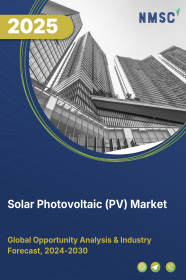
Solar Photovoltaic (PV) Market Size by Component (Modules, Inverters, and Balance of System (BOS)), by Grid Type (On-grid and Off-grid), by Material (Silicon and Compounds), by Technology (Monocrystalline Silicon, Crystalline Silicon, Thin Film, Multicrystalline Silicon, and Others), by Installation Type (Ground Mounted, Rooftop PV, Building Integrated Photovoltaics (BIPV), Floating PV, and Others), and by Application – Global Opportunity Analysis and Industry Forecast 2023-2030
Market Overview
The global Solar Photovoltaic (PV) Market size was valued at 174.52 billion in 2022 and is predicted to reach 551.25 billion by 2030 with a CAGR of 17.9% from 2023-2030. Solar PV, short for Solar Photovoltaic, is a cutting-edge technology that harnesses solar energy and converts it into electricity using semiconductor materials, typically silicon, to absorb sunlight and generate an electric current.
The process occurs within solar panels, also known as solar modules, which are interconnected to form an array. The generated electricity can be utilized immediately or stored in batteries for later consumption. Solar PV has gained widespread recognition as a clean and renewable energy source, offering numerous environmental benefits and cost-effectiveness. By operating without greenhouse gas emissions or harmful by-products, Solar PV presents an eco-friendly alternative to traditional fossil fuel-based power generation. Its versatility enables a wide range of applications, empowering homes, businesses, and communities to embrace sustainable and self-sufficient energy solutions, aligning with the global drive towards a greener and more sustainable future.
Market Dynamics and Trends
The increasing global demand for electricity, driven by population growth, urbanization, and economic development, is boosting the solar PV market. Solar PV's scalability, flexibility, and cost-effectiveness make it an essential and growing source of electricity in meeting the rising energy needs sustainably. Moreover, the escalating demand for clean and renewable energy sources to address climate change and reduce greenhouse gas emissions is driving the adoption of renewable energy solutions, further fueling the growth of the solar PV market.
Furthermore, the implementation of favorable government policies that support and promote the adoption of sustainable energy alternatives worldwide is driving the expansion of solar PV installations across the globe is further boosting the growth of the market. According to the federal government of the U.S., it offers a tax credit that can cover up to 26% of the expenses incurred for solar energy installation, while numerous states also offer additional tax rebates as incentives for utilizing solar power.
However, the limited availability of raw materials, especially silicon, for solar panel production is expected to restrain the solar PV market. On the contrary, the introduction of advanced technologies in solar PV such as tandem solar cells and perovskite solar cells, which integrate multiple semiconductor layers to achieve higher energy conversion efficiency, is expected to create ample opportunities in the growth of the market in the coming years.
Market Segmentation and Scope of Study
The global solar photovoltaic (PV) market report is segmented on the basis of component, grid type, material, technology, installation type, application, and geography. On the basis of component, the market is divided into modules, inverters, and balance of system (BOS). On the basis of grid type, the market is classified into on-grid and off-grid. On the basis of material, the market is segmented into silicon and compounds.
On the basis of technology, the market is classified into monocrystalline silicon, crystalline silicon, thin film, multicrystalline silicon, and others. On the basis of installation type, the market is divided into ground mounted, rooftop PV, building integrated photovoltaics (BIPV), floating PV, and others. On the basis of application, the market is classified into residential, commercial & industrial, and utilities. Geographical breakdown and analysis of each of the aforesaid classifications include regions comprising of North America, Europe, Asia-Pacific, and RoW.
Geographical Analysis
Asia Pacific dominates the global solar photovoltaic (PV) market share and is potently expected to remain dominant in the market throughout the forecast period. This is attributed to the government policies and incentives to promote & deploy solar PV plants in emerging countries such as India, China, and South Korea. According to the Indian government Union Budget 2022-23, about USD 410 million was allotted to boost high-efficiency solar module manufacturing, aligning with India's target of achieving 280 GW of installed solar capacity by 2030. The budget also aims to promote domestic manufacturing of solar PVs to support the growth of India's solar energy capacity while promoting the "One Sun, One World, One Grid" (OSOWOG) initiative for enhanced solar energy accessibility.
Moreover, the increasing developmental programs related to solar power energy taking place in countries such as China and India which is further expected to accelerate the growth of the market. For instance, in June 2022, China launched its solar power plant in space project by 2028. The ambitious project aims to capture solar energy in space and then beam it back to Earth, potentially revolutionizing renewable energy generation. The program aims to establish a solar energy station with a capacity of 1-megawatt in space, with the objective of collecting solar power beyond the Earth's atmosphere and transmitting it to Earth.
On the other hand, North America shows substantial growth in the global solar photovoltaic (PV) market owing to various governmental supportive initiatives such as tax rebates, funding, and feed-in tariff schemes. These initiatives have resulted in increased deployment of solar PV panels throughout the region. For instance, in May 2021, the government of Canada launched a new program, Canada Greener Homes initiative that offered Canadians grants of up to USD 5,000 to pay for energy-saving home upgrades. The program aims to assist homeowners in making their homes more energy-efficient, reduce monthly energy bills, and fight climate change.
Also, the presence of key players such as First Solar, Inc., Canadian Solar Inc., and SunPower Corporation are making investments for their business expansion in the region is further expected to boost the growth of the market. For instance, in August 2022, First Solar, Inc. announced an investment of USD 1.2 billion to increase the production of photovoltaic (PV) solar modules that are made in America and produced responsibly. This investment assists in the nation's shift to a decarbonized future and facilitated efforts to combat climate change. The investment is expected to increase the company's capacity to produce American-made solar modules for the U.S. solar market to more than 10 gigawatts (GW)DC by the year 2025.
Competitive Landscape
The solar photovoltaic (PV) industry includes several market players such as Canadian Solar Inc, Waaree Energies Ltd., First Solar, Trina Solar, Yingli Solar, Wuxi Suntech Power Co. Ltd, , AccionaEnergia S.A, eSolar Inc, Tata Power Solar Systems Ltd, JinkoSolar Holding Co. Ltd, SolarEdge Technologies Inc, Hanwha Solutions, Adani Group, RenewSys Pvt. Ltd., and Premier Energies among others. These market players are adopting product launches as their key developmental strategy to maintain their dominance in the global market.
For instance, in October 2022, JinkoSolar launched its second-generation Tiger Neo panel family, which offers one of the world's most efficient and powerful solar panels with module efficiency reaching up to 23.23% and power output up to 615Wp for the 72-cell panel. The upgraded panels feature improved performance, enhanced reliability, and unmatched low-light performance, making them a top choice for solar PV systems under various environmental conditions.
Moreover, in May 2022, Trina Solar Co., Ltd. launched a new generation of Vertex S and Vertex rooftop modules, which utilize innovative G12R-210 cells. This marks a significant improvement to the 210mm Vertex technology platform. The new product generation is suitable for all kinds of rooftops. The new product is well-suited for installation on all types of rooftops, reaffirming Trina Solar's position as a market leader in the deployment of residential, commercial, and industrial rooftop solar systems globally.
Also, in May 2022, SolarEdge Technologies, Inc. launched SolarEdge Home, a portfolio of home energy management products and solutions. SolarEdge Home is an advanced home energy management system that enables homeowners to optimize their solar energy production, usage, and storage. It includes a range of smart devices such as Home Inverters, Home Battery, Backup Interface, EV Charger, Hot Water Controller, and smart meters, along with an operating system that synchronizes and manages these components.
Key Benefits
-
The report provides quantitative analysis and estimations of the solar photovoltaic (PV) market from 2023 to 2030, which assists in identifying the prevailing market opportunities.
-
The study comprises a deep-dive analysis of the solar photovoltaic (PV) market including the current and future trends to depict prevalent investment pockets in the market.
-
Information related to key drivers, restraints, and opportunities and their impact on the global market is provided in the report.
-
Competitive analysis of the players, along with their market share is provided in the report.
-
SWOT analysis and Porters Five Forces model is elaborated in the study.
-
Value chain analysis in the market study provides a clear picture of roles of stakeholders.
Solar Photovoltaic (PV) Market Key Segments
By Component
-
Modules
-
Inverters
-
Balance of System (BOS)
By Grid Type
-
On-grid
-
Off-grid
By Material
-
Silicon
-
Compounds
By Cell Type
-
Full-Cell PV Modules
-
Half-Cell PV Modules
By Technology
-
Monocrystalline Silicon
-
Crystalline Silicon
-
Thin Film
-
Multicrystalline Silicon
-
Others
By Installation Type
-
Ground Mounted
-
Rooftop PV
-
Building Integrated Photovoltaics (BIPV)
-
Floating PV
-
Others
By Application
-
Residential
-
Commercial & Industrial
-
Utilities
By Region
-
North America
-
U.S
-
Canada
-
Mexico
-
-
Europe
-
UK
-
Germany
-
France
-
Italy
-
Spain
-
Denmark
-
Netherlands
-
Finland
-
Sweden
-
Norway
-
Russia
-
Rest of Europe
-
-
Asia-Pacific
-
China
-
Japan
-
India
-
South Korea
-
Australia
-
Indonesia
-
Singapore
-
Taiwan
-
Thailand
-
Rest of Asia-Pacific
-
-
RoW
-
Latin America
-
Middle East
-
Africa
-
Key Players:
-
Canadian Solar Inc
-
Waaree Energies Ltd.
-
First Solar
-
Trina Solar
-
Yingli Solar
-
Wuxi Suntech Power Co. Ltd
-
AccionaEnergia S.A
-
eSolar Inc
-
Tata Power Solar Systems Ltd
-
JinkoSolar Holding Co. Ltd
-
SolarEdge Technologies Inc
-
Hanwha Solutions
-
Adani Group
-
RenewSys Pvt. Ltd.
-
Premier Energies




















 Speak to Our Analyst
Speak to Our Analyst

























